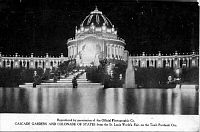
Wireless was the hot application of the turn of the century. For the St. Louis World's Fair in 1904, the great Marconi was invited by the Governer of Missouri. Marconi heard that his arch-rival Lee DeForest and other competitors would be there.
As the market leader, Marconi decided he shouldn't both lending legitimacy to his competitors, particularly at what he figured would be a short-term exhibit. Marconi concentrated on "real things" such as sending a message across the Atlantic Ocean on December 12, 1902, a stunt that got him on the front page of the New York Times. [Douglas, p. 72]
While Marconi turned down the offer to participate, Lee DeForest was never one to turn down an opportunity for exposure. He spent $10,000 to take a sight seeing tower from Niagra falls and re-erected it in St. Louis (with the discrete addition of his name emblazoned in lights across the top).
The tower was legitimate, used for experiments such as supporting the first automobile equiped with a wireless receiver. Just to make sure that people saw all these experiments (and the DeForest name), the operators were told that whenever crowds started to thin around the tower, they were to emit as loud a spark as possible, audible a quarter mile away.
The 300 foot tower DeForest built was the largest structure in St. Louis and the zenith of his career. Altough DeForest had a beautiful 3-bedroom house near the fair, cpomlete with cook and servants, he had a cot brought to the top of the tower. At night, he would enjoy the cool night air, then fall asleep. During the day, the tower was used to send messages to the "Wireless Auto. No. 1," but also to Chicago, Illinois and Kansas City, Missouri. [Lewis, p. 44]
On Electricity Day, DeForest recieved the Grand Prize Medal for General Excellence in Wireless Telegraphy. At the time, people didn't know what would happen with their technologies. AT&T was soon making big money acting as the transportation network to bring feeds from one radio station to another. While the telephone was a broadcast medium, wireless was envisioned as a point-to-point communication mechanism. Edwin Armstrong's invention of Frequency Modulation (FM) turned the tables, and soon the airwaves were being used to send broadcasts out to huge audiences, and the telephone became the way individuals talked.
Sources
Susan J. Douglas, Inventing American Broadcasting: 1899-1922, John Hopkins (Baltimore, 1987).
Tom Lewis, Empire of the Air, HarperCollins (New York, 1991). Wonderful book about David Sarnoff, Edwin Armstrong, and Lee DeForest and their fights to invent (or control) the airwaves of America. This book was made into a program on PBS produced by Ken Burns.

